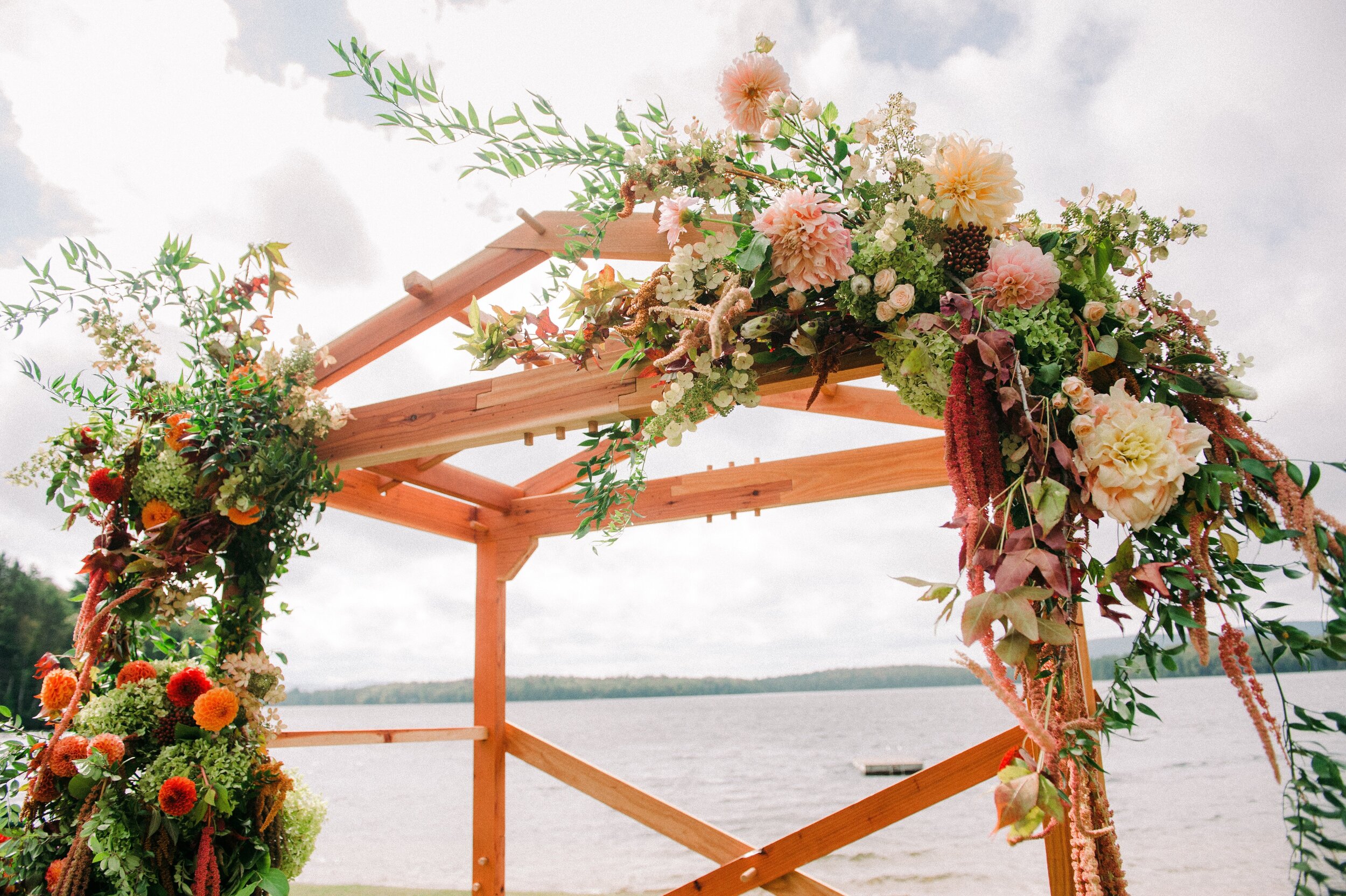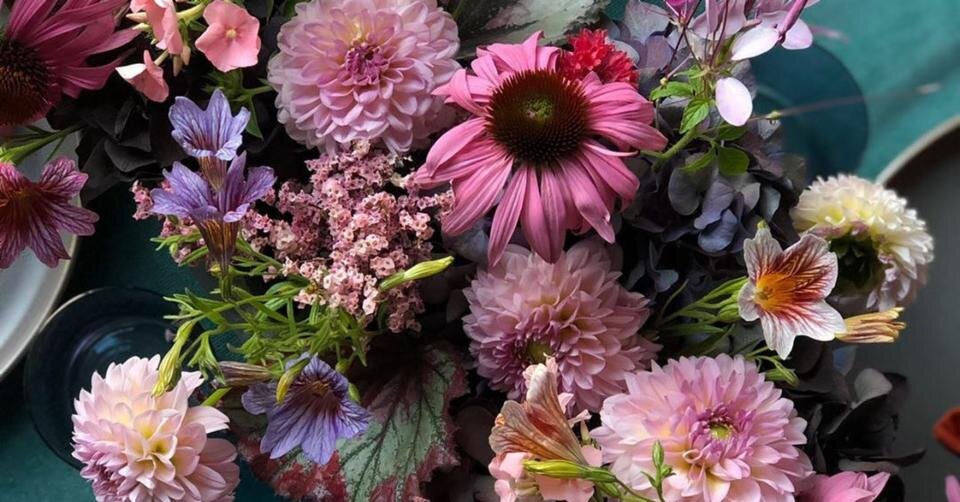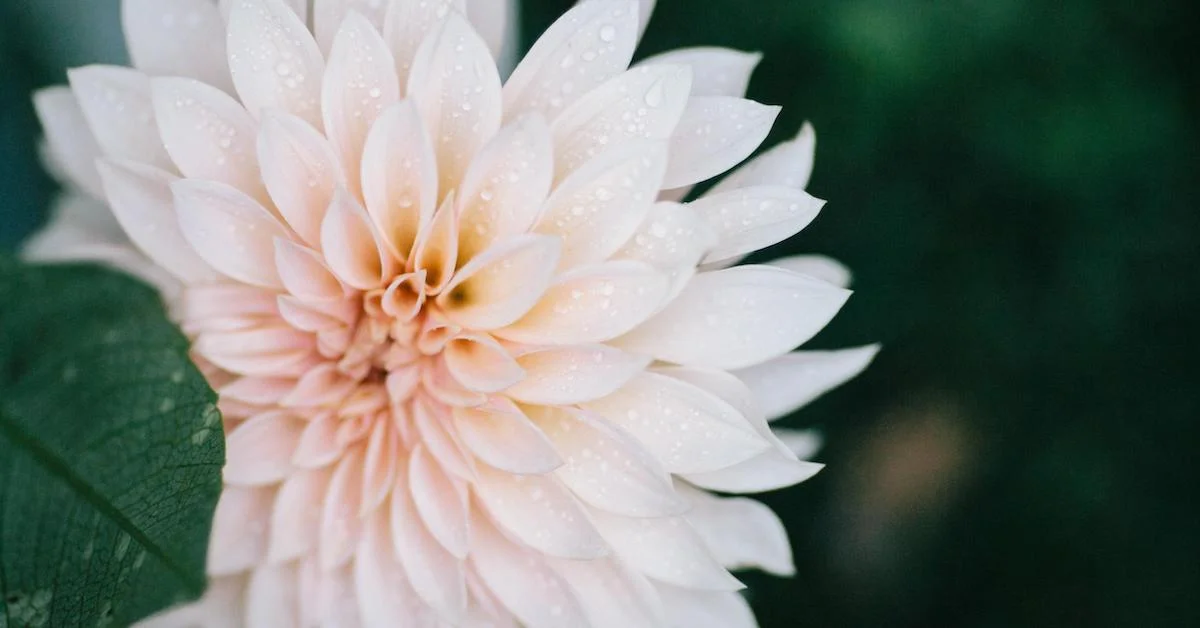How to Practice Sustainable Floral Design for Destination Weddings
I grew up in a small town, surrounded by redwood trees, on the northern coast of California. The majority of the people around me were what I endearingly call hippies, people who felt their impact on the earth more than most. As such, I grew up eating fruits, veggies, and bulk foodstuffs from the local Co-Op, recycling was as natural as breathing, and the smell of patchouli oil makes me think of Saturday morning farmer’s markets.
After a long and winding road, I find myself an adult—a professional studio florist, an organic micro flower farmer, and a professor of Forestry and Range Management in the Central Valley of California. You might say that I have a bias toward sustainability, and I try whenever possible to keep my impact on the earth as light as I can. However, I also have to balance my affinity for eco-conscious floral design with the ability to provide high end, high impact design for my bridal clients, whatever the conditions.
So you want an eco-friendly, sustainable wedding? And the venue is on an island, only accessible by boat? Across the country? This conversation began one fine spring day this year, as I was speaking with a bride about her upcoming wedding plans. The bride is an outdoor education specialist, while the groom is a construction manager specializing in the preservation of timber frame buildings. Both are nature enthusiasts with deep roots in the exploration of our wild lands. But I was wondering how to practice sustainable floral design for a destination wedding—when you don’t have your normal tools, sources, and go-to stores for last-minute fixes.
Of course, like any good florist, my answer was, Absolutely I can do that for you, and my journey into eco-friendly destination wedding design became less of a personal exploration and more of a trek that would test my limits as a woman and designer. I had no idea it would lead to the growth of an innate confidence and understanding of how to utilize the community around me, even as I left my own community thousands of miles behind.
To shift from traditional methods to eco-friendly at first seems strange, especially since designers tend to lean on floral foam as a design aid. I am not anti-foam in any way, but I think it is imperative to know the impacts of floral foam on the environment and also be realistic about the limitations foam has for design.
In the right applications, knowing how to manipulate foam as a structural tool is essential for all designers. I primarily serve the Central Valley of California, with temperatures regularly reaching over 100 degrees into the fall wedding season, believe me, I can soak a block with the best of them! However, this wedding was going to require all my construction skills, as I was flying across the country with only a carry-on sized bag of materials. The rest of my supplies I would have to source at the location—which was a rural hardware store—after I flew in on a six-seater puddle-jumper plane.
What Tools to Pack for an Eco-Friendly Destination Wedding
Here it is: the case that flew with me from California to Boston. I packed it as full as I could and checked it so I could terrify TSA with my knives, shears, and liquid-filled spray bottles without getting arrested. This case created a full arbor, 24 large centerpieces, and all the personal flowers for the entire wedding—and it weighed next to nothing.
So what’s in the case? Great question—here is my secret list. (You know, just the essentials!)
24 Flora Guppies (find them here: https://www.floraguppy.com/). They come in 2 pieces, so they stacked neatly in my box and held pins, ribbon, and shears.
A 6-inch and a 4-inch design egg
A large design pillow
A roll of Oasis design mesh
Shears
Green pot tape
Clear design tape
Spray bottle filled with Crowning Glory
Bind wire
Silk ribbon
Pins
Straight wire
Wire cutters
Rose strippers
Various zip ties
My favorite knife
Be Adaptable
Now, here is the part that is the nightmare of every florist: the airline LOST my checked bag. Anything can happen at an event; add in the factors of a destination wedding, and you have to plan to be adaptable.
The whole flight from Boston, I knew my bag was gone, and I only had the clothes on my back, my wallet, and my breast pump. I was in so much trouble! My first stop after landing was the hardware store, where I picked up every single bag of sphagnum moss they had, a roll of electrical tape, wire cutters, pruners, chicken wire, and planter liner trays.
Jason Hupe Photography
SOURCE SUSTAINABLY
My visit to the hardware store took care of my mechanics, but how did I get the floral material for the wedding? I sure couldn’t pack that! This took a little bit of thinking. Ultimately, I had an order of woody greens flown in from my local suppliers in California, and it was waiting for me at the Fed-ex center in the grocery store. Small town.
I picked up those boxes and headed for the wedding venue, still an hour from where I was. While I was flying, a local farm delivered the amazing blooms to the venue, and I couldn’t wait to see them! I had posted in a Facebook group for flower farmers about needing these blooms and where the wedding was located, and I got into contact with the perfect farm! This is a resource I will use again, and it made having the freshest possible product easy. Don’t be afraid to reach out to people via social media; it works! I also appreciated that I had flowers that were seasonally appropriate and supported local agriculture—something that was very important for both me and the bridal couple.
Jason Hupe Photography
Use Sphagnum Moss
Regardless of my luggage getting lost, I was planning on using the sphagnum moss as my water source for the flowers. It composts amazingly well and can be dried out and rehydrated as often as needed—reusable and recyclable! Remember, I am a wedding designer, not retail, so I only need to keep my flowers happy for two days max, and the ambient temperature of the Adirondak region was under 75 degrees—the perfect conditions for moss. I cannot stress this enough: conduct ample background research on your flowers and your location, especially if you do a lot of destination weddings.
The use of moss as a water source was great for another reason: the lakeshore the wedding was at can be quite windy. A few weeks before this wedding, I was working on the banks of a pond, and my designs kept blowing over again and again. Now, if I was using foam, I would be heartbroken because it shatters when it falls, becoming unusable. But thankfully, I had used moss to fill my guppys, pillows, and eggs, so all I did was pick them up and put them back. Not a single stem shifted. It was a revolutionary moment for me.
For this destination wedding, I used chicken wire sausages filled with moss and attached with electrical tape. I was still hoping my luggage would catch up with me, so I reversed my design schedule and constructed the arbor first thing, the day before the wedding. Despite the winds reaching 20 miles per hour, the next morning, I only had to pick up three stems off the ground. Even the fickle dahlias looked bright and cheerful! My bag did end up making it, so I was able to fill my guppies and pillows, tape them to the planter liners (poor gal’s lomey dish), and go to town on the centerpieces.
This eco-friendly destination wedding design experience left me feeling victorious; I had encountered so many challenges and not only fulfilled the wedding to order and brand standard, but I also surpassed even my own expectations about what was possible with eco-friendly sustainable design.
After this wedding, I started integrating moss and reusable armatures into other weddings. I even built a 20-foot tall tree from flowers without a single block of foam. The best thing we can do as designers is to have the largest toolbox possible, knowing when to use which tool!












